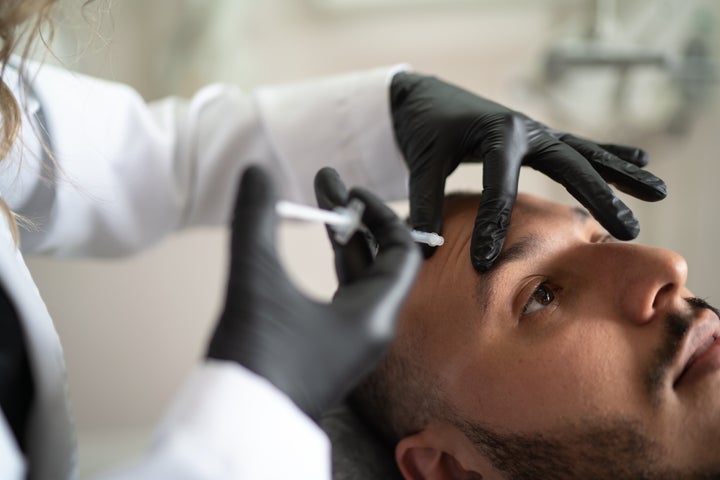Though it’s still more popular among women, Botox has gained a foothold among male patients as well — but the treatment slightly differs.
First introduced to the general public in the late 1980s, Botox has now become a billion-dollar industry that has challenged our relationship with beauty, wellness, plastic surgery, ageism and even gender ― it’s not just women who are getting the procedure.
According to the 2020 plastic surgery statistics report by the American Society of Plastic Surgeons, in 2020, women received about 4 million Botox-type treatments while men underwent just over 250,000 procedures of the kind.
Although there’s still a large difference in number of treatments between the two genders, experts are quick to note that, in the past few years, there has been a sharp increase in desire for the muscle-freezing, wrinkle-reducing injection among a range of people.
“While Botox is and has traditionally been more popular among women, various sources have demonstrated that it has been growing in popularity among men, as well,” said Dr. Samuel Lin, a board-certified plastic surgeon and associate professor of surgery at Harvard Medical School.
Facial plastic surgeon Dr. Jacob D. Steiger has also noticed the trend. “We are seeing the proportion of men versus women increasing,” he noted, “meaning the male segment is increasing at a higher rate. This is jokingly referred to as ‘brotox.’”
According to the American Society of Plastic Surgeons, “brotox” is the No. 1 cosmetic procedure requested by men, with a 400% increase in treatments administered since 2000.
Overall, men and women seem to concentrate on the same area of the face when undergoing treatment: the forehead.
In the past, “people preferred a more total effect to the point that they looked expressionless,” explained Dr. Bruce Hermann, a board-certified plastic surgeon. “Today, I find that the majority of women prefer the maximal effect possible without having a frozen forehead. For men, I find that in general they prefer an effect similar to women but a bit more subtle on the forehead.”
Male vs. Female Botox
Although men and women tend to seek Botox treatments on similar areas of the face, experts note that the procedures differ based the gender one was assigned at birth. As a general statement, given their larger muscle mass in the facial musculature, men need more Botox than women do to obtain similar effects.
“For example, in the glabellar area [the skin between your eyebrows], for a similar effect, I start women with about 15 units of Botox and go up as needed to achieve the desired result,” Hermann shared. “For men, I would normally recommend starting with 20 units and adjusting from there.”
The expert is quick to note that the approach gets more complex when dealing with patients’ foreheads. “Men commonly prefer a more subtle effect in the area,” he said. “So I’ll use a higher dosage per area in men but inject a smaller surface area.”
As long as the dosage is adjusted, the frequency of injection is the same for men and women, Steiger said. For most patients, results last about four months.

Anatomical variations in skin composition can also potentially lead to gender-specific differences in terms of reactions and complications. “Men typically have thicker skin with higher collagen composition compared to women,” Lin explained. “Male skin also tends to be more vascular, which carries a higher complication rate of bleeding and bruising when injecting Botox.”
Although based on anecdotal evidence, some physicians also believe that Botox wears off faster in men given their metabolism. However, Lin explained that this should be discussed directly between a patient and doctor, because it’s not easy to generalize “given broad differences in human metabolism.”
In short: Men and women look to address similar facial issues when getting Botox, but the dosages needed to reach similar results can vary.
The Future Of Botox
Experts, including Hermann, believe the overall trends will stay the same in the future: Men and women will continue seeking to tackle similar facial issues through the treatment. Although more women than men are likely to undergo the procedure, “the percentage of men getting Botox will increase slightly each year,” Hermann predicted.
The surgeon specifically calls out ageism in the workforce. Although ageism was once an issue commonly mentioned by women in the workforce, it affects men as well.
Case in point: In 2019, Google settled an age discrimination lawsuit concerning its hiring practices. As a result, over 200 job seekers over the age of 40 who had applied for positions at the company received a settlement of $11 million.
COVID-19 also changed things. “The ‘Zoom effect’ is a phenomenon brought on by the pandemic whereby people working from home saw themselves more frequently on camera and started to notice things that made them look more aged,” Hermann said. “A study by the American Society of Plastic Surgeons in 2020 showed an increase in interest in plastic surgery or non-surgical procedures like Botox to look younger in 11-35% of women surveyed that were using Zoom or similar platforms.”
If you’re ever considering a Botox treatment, here’s how to find a reputable provider.
Credit: Source link